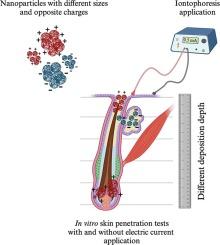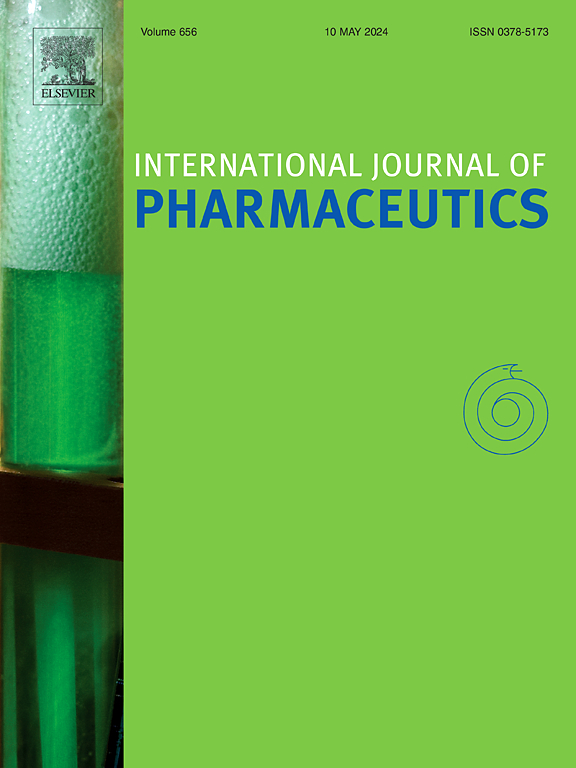明胶纳米颗粒的大小和电荷对毛囊离子导入定向沉积的影响
IF 5.3
2区 医学
Q1 PHARMACOLOGY & PHARMACY
引用次数: 0
摘要
毛囊(HF)是治疗多种皮肤病的一种重要给药途径。另一方面,离子渗透是一种物理方法,通过对制剂施加低电流来增强药物渗透。局部离子透入疗法可针对高频,因为高频是电阻较低的途径,同时也是药物储存库,对纳米颗粒(NPs)尤其有用,因为纳米颗粒可在这些结构中积聚。将这两种策略结合起来可获得最佳效果,但文献中仍缺乏针对高频离子透入给药的理想 NP 特性的证据。在此,我们旨在评估明胶 NPs 的大小和电荷在离子透入应用中对 NPs 沉积到高频的影响。我们制备了四种不同明胶浓度和明胶类型(带正电荷的 A 型和带负电荷的 B 型)的明胶 NP 配方,其尺寸从 220 纳米到 770 纳米不等。为监测 NPs 沉积情况,还封装了一种荧光染料(TRITC-葡聚糖 150 kDa)。在体外用猪耳皮肤进行了 6 小时的皮肤穿透实验,包括离子透入和不离子透入。共聚焦激光扫描显微镜对沉积概况进行了评估。显微照片显示,带正电荷的较大型 NPs(AL)聚集较多,达到高频的较深部位,并显示电离子渗透进一步增加了它们的沉积,从而产生最高的信号。总之,这些发现揭示了 NPs 的应用领域,并为多种损害毛囊的疾病带来了新的治疗机会。本文章由计算机程序翻译,如有差异,请以英文原文为准。

Effect of gelatin nanoparticles’ size and charge on iontophoretic targeted deposition to the hair follicles
Hair follicles (HFs) represent a route of interest to drug delivery for treating several skin conditions. Iontophoresis, on the other hand, is a physical method to enhance drug permeation by applying a low electrical current to the formulation. HFs can be targeted following topical iontophoretic application, as they represent a pathway of lower electrical resistance, as well as a drug reservoir, in particular useful for nanoparticles (NPs), which can preferably accumulate in these structures. Combining both strategies may provide optimal results, but the literature still lacks evidence of the ideal NP characteristics for the iontophoretic drug delivery targeting the HFs. Here, we aimed to evaluate the effect of gelatin NPs’ size and charge under iontophoresis application on NPs’ deposition into the HFs. Four gelatin NP formulations were produced with varying gelatin concentrations and gelatin types (positively charged type A and negatively charged type B), with sizes ranging from 220 to 770 nm. A fluorescent dye, TRITC-dextran 150 kDa, was encapsulated for monitoring NPs deposition. Cutaneous penetration experiments were performed in vitro with and without iontophoresis for 6 h with pig ear skin. The deposition profile was assessed by confocal laser scanning microscopy. Photomicrographs showed a higher accumulation of the larger positively charged NPs (AL), reaching deeper portions of HFs, and showed iontophoresis further increased their deposition, resulting in the highest signal. In conclusion, these findings shed light on the applications of NPs and bring novel treatment opportunities for several diseases compromising the hair follicles.
求助全文
通过发布文献求助,成功后即可免费获取论文全文。
去求助
来源期刊
CiteScore
10.70
自引率
8.60%
发文量
951
审稿时长
72 days
期刊介绍:
The International Journal of Pharmaceutics is the third most cited journal in the "Pharmacy & Pharmacology" category out of 366 journals, being the true home for pharmaceutical scientists concerned with the physical, chemical and biological properties of devices and delivery systems for drugs, vaccines and biologicals, including their design, manufacture and evaluation. This includes evaluation of the properties of drugs, excipients such as surfactants and polymers and novel materials. The journal has special sections on pharmaceutical nanotechnology and personalized medicines, and publishes research papers, reviews, commentaries and letters to the editor as well as special issues.

 求助内容:
求助内容: 应助结果提醒方式:
应助结果提醒方式:


